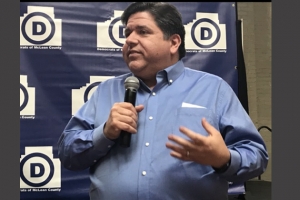
By Illinois Radio Network
SPRINGFIELD – It’s unclear what Illinois Gov. J.B. Pritzker’s plans are to address the growing unfunded pension liabilities that a shrinking number of Illinois taxpayers are increasingly on the hook for. He barely addressed pension debt and didn’t talk about the state leading the country in population loss.
Of a $40 billion budget, Illinois taxpayers put more than $9 billion in the state’s five public employees’ pension funds this fiscal year. It’ll be $10 billion next fiscal year. Funding levels are set to ramp up for several years ahead, taking resources from other taxpayer-provided services.
“We’re making the payments as scheduled because if we continue to do that we’ll be funded by 2045, 90 percent,” state Sen. Robert Martwick, D-Chicago, said.
Recent audits show a mixed bag of some pension systems’ unfunded liability going up, others going down, but overall the funds are about 40 percent funded.
Before the governor’s State of the State Address last week, Martwick said he hoped the governor addresses the issue.
“We hope to see that there’s going to be a push to really analyze that ramp and see what the solution is going forward,” Martwick said.
Pritzker mentioned pension buyouts and local pension consolidation, but didn’t address the growing taxpayer cost.
“We’ve also begun the long work of tackling our pension problems,” the governor said Wednesday. “In addition to expanding our state pension buyout program, in the fall veto session we … [consolidated] 650 downstate and suburban first responder pension systems.
“These changes, along with our landmark pension reform that consolidated police and firefighter pensions, can make a serious dent in property taxes,” he said.
After the speech. House Minority Leader Jim Durkin, R-Western Springs, said taxpayers need to see how the state plans to address the $200 billion debt.
“Everybody wants to say that we can’t do anything short of changing the [state] constitution but people have stuck their heads in the sands since the [state] Supreme Court came down about five years ago and they just try to ignore the problem we have with our five pensions systems,” Durkin said. “I haven’t.”
The Illinois Supreme Court in 2015 ruled against a pension reform effort saying the state cannot reduce benefits that were promised. The idea of changing the state constitution through a ballot question for voters to decide whether to allow for pension reductions isn’t considered to advance at the statehouse.
Without providing details, Durkin said he plans to release statements about addressing Illinois’ pension debt sometime during this session.
On pension buyouts, the architects of the programs meant to save taxpayers on growing pension costs say there are mixed results.
Before the governor’s speech last week, Martwick and state Rep. Mark Batinick, R-Plainfield, said they planned to meet with the governor to talk about the performance of the pension buyouts.
“Some systems have had exceptionally good performance, and some have had abysmally low performance and so we’re looking at that and trying to figure out what we can do to make those more attractive,” Martwick said. “The more people that opt into them, the more money the state saves.”
The Teachers’ Retirement System, the state’s largest retirement fund, provided an update on their two buyout programs Friday.
“The first is the ‘AAI’, or Accelerated Annual Increase,” said TRS Communications Director Dave Urbanek. “This is available for all retiring Tier 1 members, if they decide to accept it. In the year the program’s been available, we’ve had 4,170 members become eligible for the option. 639 members have elected to accept the AAI, which is 15.3 percent of eligible members. For all of these 639 members, they will be paid $80.8 million. That $80.8 million is, technically, the ‘savings’ to TRS, although you have to remember that the funding for both programs comes from the sale of state bonds.
“The second is the ‘APB,’ or Accelerated Pension Benefit,” he said. “This is available to all Tier 1 and Tier 2 inactive members. As required by the law, we notified 14,599 eligible inactive members about the program and gave them an initial estimate of what their payment would be. The program started in the fall once we nailed down the updated number of inactive members (14,599) following the close of the books on the 2018-2019 school year. So far 814 members have accepted this buyout, or 5.6 percent of everyone who’s eligible. They will be paid $98.6 million. Again, these funds come from the sale of state bonds.”
TRS’s unfunded liability grew this year by more than $3 billion, to a total of $81.1 billion.
Batinick agreed the buyout programs need to be more attractive, but he said Illinois also needs to reverse the loss of population.
“We’re losing high income earners, and we’re attracting lower income earners, and it’s a net loss there,” Batinick said. “When you start spreading those costs over more people, plus then there will be more Tier II people (with lower pension benefits) versus Tier I, it’s certainly a way to address the problem.”
Illinois led the nation in outbound migration for the decade, something else the governor didn’t address in his State of the State speech last week.
Illinois Radio Network can be reached at [email protected].






